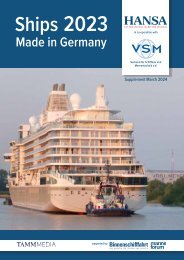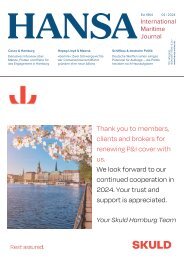HANSA 01-2020
Versicherungssteuer | Shortsea Shipping | Bulk-Schifffahrt | Abwasser-Technologie | Coatings | Wertschöpfung Offshore-Wind | Schwerpunkt P&I | Review HANSA-Forum 2019
Versicherungssteuer | Shortsea Shipping | Bulk-Schifffahrt | Abwasser-Technologie | Coatings | Wertschöpfung Offshore-Wind | Schwerpunkt P&I | Review HANSA-Forum 2019
Sie wollen auch ein ePaper? Erhöhen Sie die Reichweite Ihrer Titel.
YUMPU macht aus Druck-PDFs automatisch weboptimierte ePaper, die Google liebt.
Schifffahrt | Shipping<br />
tivity in 2<strong>01</strong>9. These factors should be<br />
partly offset by lower optimal operating<br />
speeds for ships due to higher costs<br />
associated with low-sulphur fuel usage<br />
following the implementation of IMO<br />
<strong>2020</strong>,« the agency’s report says. Vessels<br />
with a combined capacity of more than<br />
45 mill.DWT are scheduled to be delivered<br />
in <strong>2020</strong>, up from about 30 mill.DWT<br />
in 2<strong>01</strong>9, according to data from Clarksons<br />
Research. The uptrend in rate of vessels<br />
being out-of-service for scrubber fittings<br />
in 2<strong>01</strong>9 should also reverse next year.<br />
But BIMCO’s Chief Shipping Analyst,<br />
Peter Sand, warned in a recent dry bulk<br />
market report: »The fundamental balance<br />
in the market has worsened in 2<strong>01</strong>9 with<br />
supply growth outpacing that of demand.<br />
He expects this to continue into <strong>2020</strong>.<br />
»This will do nothing to help shipowners<br />
pass on the additional costs of the looming<br />
IMO <strong>2020</strong> sulphur cap, which is set to<br />
add even more pressure to already struggling<br />
bottom lines«, he said.<br />
»BDI could jump by 15%-20%«<br />
Meanwhile, Fitch stands by its quite bearish<br />
outlook: »We expect freight rates to<br />
rise in <strong>2020</strong>, driven by improved supply/demand<br />
balance and an increase in<br />
fuel cost. We think the Baltic Dry Index,<br />
based on time-charter rate average for<br />
various vessel sizes, could jump by 15%-<br />
20% in <strong>2020</strong>, after remaining fairly flat in<br />
2<strong>01</strong>9 when supply growth has outpaced<br />
demand.«<br />
While there has been a significant recovery<br />
in the Baltic Dry Index in the second<br />
half of 2<strong>01</strong>9, the agency expects rates<br />
in <strong>2020</strong> to be less volatile for the year as<br />
a whole. The increase in annual average<br />
and relative stability in <strong>2020</strong> should be<br />
similar to the trend seen in 2<strong>01</strong>8, when<br />
both trade volume and fleet capacity grew<br />
by 3%. An 18% increase in the annual<br />
BDI average in 2<strong>01</strong>8 had followed a 70%<br />
jump in 2<strong>01</strong>7 and a recovery from historic<br />
lows in 1Q16.<br />
Bull or bear? That seems to remain the<br />
question for the year ahead. fs<br />
© Selzer<br />
<strong>HANSA</strong> International Maritime Journal <strong>01</strong> | <strong>2020</strong><br />
25


















